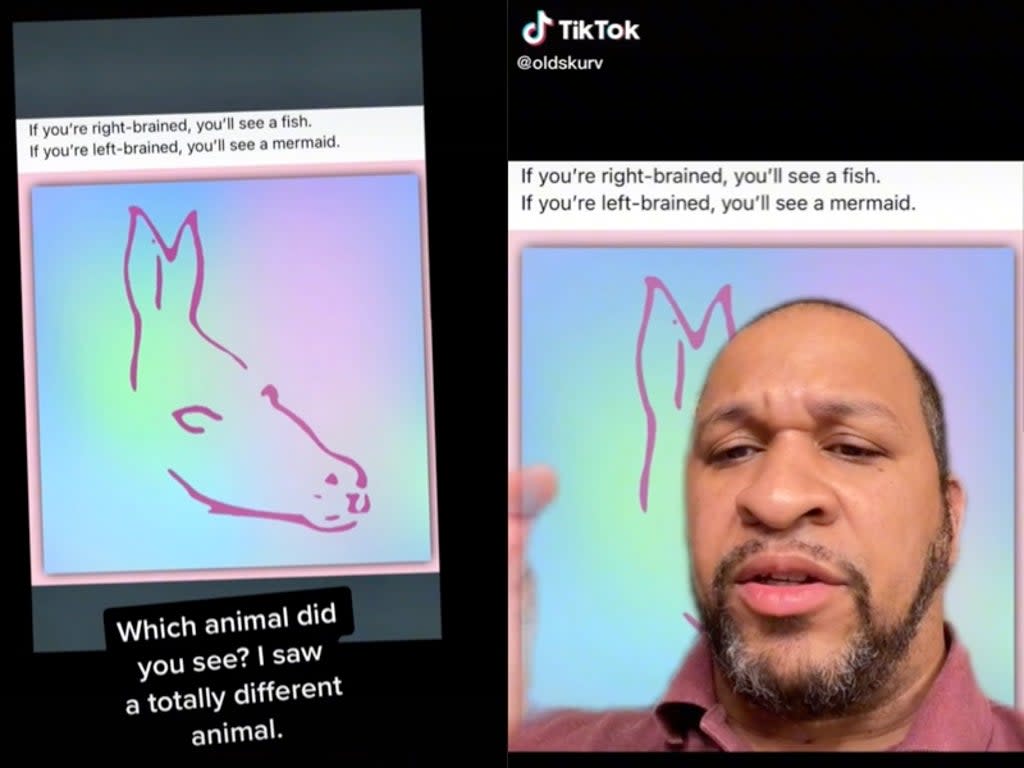People bewildered by optical illusion claiming to show mermaid or fish: ‘It’s a donkey or a seal, surely?’

The internet has been left befuddled by a viral optical illusion that claims to identify whether you are “right-brained” or “left-brained” depending on whether you see a fish or a mermaid, as most people see a donkey or a seal instead.
The viral optical illusion is depicted with a series of purple lines against a blue, purple and green gradient backdrop, with the figure sparking a divisive response reminiscent of the one that resulted from the infamous blue or gold dress.
According to one photo of the illusion circulating on social media, people who see a fish are “right-brained,” while “left-brained” individuals are those who will see a mermaid in the lines.
However, as many individuals, including Harry Potter author JK Rowling, have pointed out, the illusion more closely resembles animals such as a donkey or a seal.
“It’s a donkey, though,” the author tweeted on 19 March, with the response liked more than 143,000 times.
Others were adamant that the picture depicts a seal, with actor James Dreyfus replying: “Or a seal. No fish, no mermaid. At all.”
The hundreds of responses agreeing with Rowling prompted one person to acknowledge that many more people see a donkey or a seal than a fish or a mermaid in the illusion.
It's a donkey, though. pic.twitter.com/a60ccFCQ2G
— J.K. Rowling (@jk_rowling) March 19, 2022
“Does anyone see a mermaid? Or, indeed, a fish? It’s a donkey or a seal, surely??” they wrote, while another said: “First glance, donkey. Second look, seal. Never a fish OR mermaid.”
What happens if you're seeing an adorable baby seal https://t.co/2VL8ryEs8X
— TyberiusAsher (@tyberius_asher) March 21, 2022
It's clearly a seal. https://t.co/rO9pgVoovW
— Rock Von Wolf (@Rock0101010) March 21, 2022
I see the donkey…and a seal https://t.co/l9HhqjlinY
— Derk (@DerekSammartino) March 21, 2022
The debate also made its way to TikTok, where one user shared a photo of the illusion and said: “I saw this on Twitter. If you’re right-brained, you’ll see a fish. If you’re left-brained, you’ll see a mermaid. And all I see is a damn horse.”
@oldskurv #greenscreen mermaid, fish, or horse. You decide.
♬ original sound - Oldskurv
While most people were resolute in their beliefs that the optical illusion portrays a seal or a donkey, others were jokingly concerned by their inability to see the mermaid or fish.
“It’s a seal, thank you, so now I don’t have a brain or what?” one person jokingly commented, while another wrote on Twitter: “My brain is broken because I don’t know how anyone can see a fish or mermaid. I do see the donkey if I try but all I see is a seal.”
Others noted that the illusion is not new, as a version of the drawing, without the colourful background, has been around a long time and is referenced in a 2010 study published in the British Journal of Developmental Psychology about children with autism. In the study, the children were tasked with determining whether a similar line image depicted a donkey or a seal.
“Not even sure why this image is on Twitter. This seal/donkey optical illusion is like 100 years old,” one person noted.
This is actually an old optical illusion that is "seal or donkey". Someone changed it to "fish or mermaid" because it would generate tons of comments about how they see a seal or donkey.
— Kidney Stones of Jordan (@jordanclock) March 19, 2022
According to Harvard Medical School’s health blog, it is also likely that the theory that individual personality traits reside in one area of the brain is a myth. The blog states that it is typically believed that those who are “right-brained” are intuitive and creative free thinkers who tend to “experience the world in terms that are descriptive or subjective,” while those who are “left-brained” “tend to be more quantitative and analytical”.
However, the blog also notes that there has been “little or no evidence supporting” the theory, and that it is likely the theory is a myth.
“In fact, if you performed a CT scan, MRI scan, or even an autopsy on the brain of a mathematician and compared it to the brain of an artist, it’s unlikely you’d find much difference,” the blog states. “And if you did the same for 1,000 mathematicians and artists, it’s unlikely that any clear pattern of difference in brain structure would emerge.”
While the university acknowledges that more studies need to be conducted to determine the accuracy of the left/right brain concept, it notes that the authors of a recent study concluded that the notion of some people “being more left-brained or right-brained is more a figure of speech than an anatomically accurate description” after finding no evidence to support the theory when looking at the brain scans of more than 1,000 people between the ages of seven and 29.

